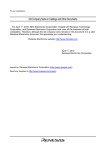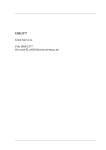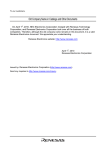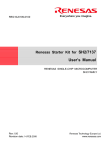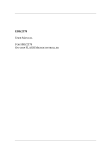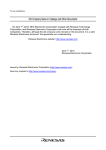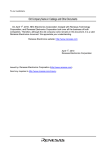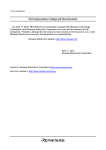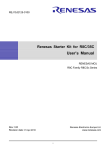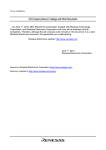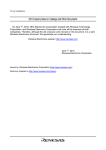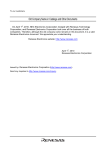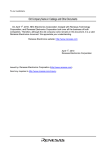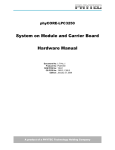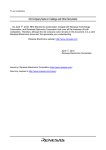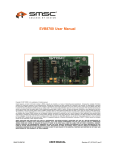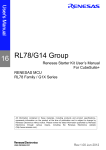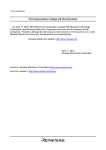Download Renesas Starter Kit for H8S/2472 User`s Manual
Transcript
REG10J0082-0100 Renesas Starter Kit for H8S/2472 User’s Manual RENESAS SINGLE-CHIP MICROCOMPUTER H8S FAMILY Rev.1.00 Revision date: 28.08.2008 Renesas Technology Europe Ltd. www.renesas.com Disclaimer By using this Renesas Starter Kit (RSK), the user accepts the following terms. The RSK is not guaranteed to be error free, and the entire risk as to the results and performance of the RSK is assumed by the User. The RSK is provided by Renesas on an “as is” basis without warranty of any kind whether express or implied, including but not limited to the implied warranties of satisfactory quality, fitness for a particular purpose, title and non-infringement of intellectual property rights with regard to the RSK. Renesas expressly disclaims all such warranties. Renesas or its affiliates shall in no event be liable for any loss of profit, loss of data, loss of contract, loss of business, damage to reputation or goodwill, any economic loss, any reprogramming or recall costs (whether the foregoing losses are direct or indirect) nor shall Renesas or its affiliates be liable for any other direct or indirect special, incidental or consequential damages arising out of or in relation to the use of this RSK, even if Renesas or its affiliates have been advised of the possibility of such damages. Precautions This Renesas Starter Kit is only intended for use in a laboratory environment under ambient temperature and humidity conditions. A safe separation distance should be used between this and any sensitive equipment. Its use outside the laboratory, classroom, study area or similar such area invalidates conformity with the protection requirements of the Electromagnetic Compatibility Directive and could lead to prosecution. The product generates, uses, and can radiate radio frequency energy and may cause harmful interference to radio communications. However, there is no guarantee that interference will not occur in a particular installation. If this equipment causes harmful interference to radio or television reception, which can be determined by turning the equipment off or on, you are encouraged to try to correct the interference by one or more of the following measures; • ensure attached cables do not lie across the equipment • reorient the receiving antenna • increase the distance between the equipment and the receiver • connect the equipment into an outlet on a circuit different from that which the receiver is connected • power down the equipment when not is use • consult the dealer or an experienced radio/TV technician for help NOTE: It is recommended that wherever possible shielded interface cables are used. The product is potentially susceptible to certain EMC phenomena. To mitigate against them it is recommended that the following measures be undertaken; • The user is advised that mobile phones should not be used within 10m of the product when in use. • The user is advised to take ESD precautions when handling the equipment. The Renesas Starter Kit does not represent an ideal reference design for an end product and does not fulfil the regulatory standards for an end product. ii Table of Contents Chapter 1. Preface .................................................................................................................................................. 4 Chapter 2. Purpose ................................................................................................................................................. 5 Chapter 3. Power Supply ........................................................................................................................................ 6 3.1. Requirements ............................................................................................................................................... 6 3.2. Power – Up Behaviour ................................................................................................................................. 6 Chapter 4. Board Layout ......................................................................................................................................... 7 4.1. Component Layout ....................................................................................................................................... 7 4.2. Board Dimensions ........................................................................................................................................ 8 Chapter 5. Block Diagram ....................................................................................................................................... 9 Chapter 6. User Circuitry....................................................................................................................................... 10 6.1. Switches ..................................................................................................................................................... 10 6.2. LEDs ........................................................................................................................................................... 10 6.3. Potentiometer ............................................................................................................................................. 10 6.4. Serial port ................................................................................................................................................... 10 6.5. USB ............................................................................................................................................................ 11 6.6. Ethernet ...................................................................................................................................................... 11 6.7. Debug LCD Module .................................................................................................................................... 12 6.8. Option Links................................................................................................................................................ 13 6.9. Oscillator Sources ...................................................................................................................................... 17 6.10. Reset Circuit ............................................................................................................................................. 18 Chapter 7. Modes.................................................................................................................................................. 19 7.1. User Boot mode.......................................................................................................................................... 19 7.2. User Program mode ................................................................................................................................... 19 7.3. Boot mode .................................................................................................................................................. 19 Chapter 8. Programming Methods ........................................................................................................................ 20 Chapter 9. Headers ............................................................................................................................................... 21 9.1. Microcontroller Headers ............................................................................................................................. 21 9.2. Application Headers ................................................................................................................................... 26 Chapter 10. Code Development ........................................................................................................................... 29 10.1. Overview................................................................................................................................................... 29 10.2. Compiler Restrictions ............................................................................................................................... 29 10.3. Mode Support ........................................................................................................................................... 29 10.4. Breakpoint Support ................................................................................................................................... 29 10.5. Memory Map............................................................................................................................................. 30 Chapter 11. Component Placement ...................................................................................................................... 31 Chapter 12. Additional Information........................................................................................................................ 32 iii Chapter 1. Preface Cautions This document may be, wholly or partially, subject to change without notice. All rights reserved. Duplication of this document, either in whole or part is prohibited without the written permission of Renesas Technology Europe Limited. Trademarks All brand or product names used in this manual are trademarks or registered trademarks of their respective companies or organisations. Copyright © Renesas Technology Europe Ltd. 2008. All rights reserved. © Renesas Technology Corporation. 2008. All rights reserved. © Renesas Solutions Corporation. 2008. All rights reserved. Website: http://www.eu.renesas.com/ Glossary CPU Central Processing Unit HEW High-performance Embedded Workshop LED Light Emitting Diode RSK Renesas Starter Kit PC Program Counter E10A On-chip debugger module ESD Electrostatic Discharge EMC Electromagnetic compatibility 4 Chapter 2. Purpose This RSK is an evaluation tool for Renesas microcontrollers. This manual describes the technical details of the RSK hardware. The Quick Start Guide and Tutorial Manual provide details of the software installation and debugging environment. Features include: • Renesas Microcontroller Programming. • User Code Debugging. • User Circuitry such as Switches, LEDs and potentiometer. • User or Example Application. • Sample peripheral device initialisation code. The RSK board contains all the circuitry required for microcontroller operation. 5 Chapter 3. Power Supply 3.1. Requirements This RSK operates from a 5V power supply. A diode provides reverse polarity protection only if a current limiting power supply is used. All RSK boards are supplied with an E10A debugger. This product is able to power the RSK board with up to 300mA. When the RSK is connected to another system then that system should supply power to the RSK. All RSK boards have an optional centre positive supply connector using a 2.0mm barrel power jack. Warning The RSK is neither under nor over voltage protected. Use a centre positive supply for this board. 3.2. Power – Up Behaviour When the RSK is purchased the RSK board has the ‘Release’ or stand alone code from the example tutorial code pre-programmed into the Renesas microcontroller. On powering up the board the user LEDs will start to flash. After 200 flashes, or after pressing a switch the LEDs will flash at a rate controlled by the potentiometer. 6 Chapter 4. Board Layout 4.1. Component Layout The following diagram shows top layer component layout of the board. Application board interface JA5 Reset switch JA1 RS232 Serial LCD Display LCD J7 Power J8 Power LED J6 J5 JA3 E8A Header MCU Microcontroller pin headers J2 J1 E10A Header USB J3 Ethernet User LEDs J4 Boot LED JA6 JA2 Application board interface Potentiometer Figure 4-1: Board Layout 7 User switches 4.2. Board Dimensions The following diagram gives the board dimensions and connector positions. All through hole connectors are on a common 0.1” grid for easy interfacing. 120.00mm 115.00mm 86.36mm Corners x4 3mm radius Short Board = 85 mm 50.80 mm 43.18 mm 35.56 mm 27.00mm SW 1 SW 2 SW 3 POT JA2 JA6 J4 J1 J2 J3 E10A ETHERNET J1 Applies to connector with microcontroller pin A1 USB J5 J6 MCU E8A J8 J7 PWR Serial D9 SKT R E S JA5 JA1 45.00mm Figure 4-2: Board Dimensions 8 Chapter 5. Block Diagram Figure 5-1 shows the CPU board components and their connectivity. Figure 5-1: Block Diagram Figure 5-2 shows the connections to the RSK. Figure 5-2: RSK Connections 9 Chapter 6. User Circuitry 6.1. Switches There are four switches located on the CPU board. The function of each switch and its connection are shown in Table 6-1. Switch Function Microcontroller RES When pressed, the RSK microcontroller is reset. RESn, Pin E4 SW1/BOOT* Connects to an IRQ input for user controls. IRQ8n, Pin L15 The switch is also used in conjunction with the RES switch to place the device in (Port 6 pin 7) BOOT mode when not using the E10A debugger. SW2* Connects to an IRQ line for user controls. IRQ9n, Pin L14 (Port 6, pin 6) SW3* Connects to the ADC trigger input. Option link allows connection to IRQ line. IRQ10, Pin L13 The option is a pair of 0R links. For more details on option links, please refer (Port 6, pin 5) to Sec 6.8. Table 6-1: Switch Functions *Refer to schematic for detailed connectivity information. 6.2. LEDs There are six LEDs on the RSK board. The green ‘POWER’ LED lights when the board is powered. The orange BOOT LED indicates the device is in BOOT mode when lit. The four user LEDs are connected to an IO port and will light when their corresponding port pin is set low. Table 6-2, below, shows the LED pin references and their corresponding microcontroller port pin connections. LED Reference (As Colour Microcontroller Port Pin shown on silkscreen) Microcontroller Pin Number LED0 Green Port F2 G13 LED1 Orange Port F3 D4 LED2 Red Port F4 B4 LED3 Red Port F6 E3 Table 6-2: LED Port 6.3. Potentiometer A single turn potentiometer is connected to channel AN0 (P7.0) of the microcontroller. This may be used to vary the input analogue voltage value to this pin between AVCC and Ground. 6.4. Serial port Serial port SCIF is connected to the standard RS232 header. Serial port SCI3 can optionally be connected to the RS232 header. The connections to be fitted are listed in the Table 6-3. 10 Description Function Microcontroller Fit for RS232 Remove for RS232 Port Pin SCIF Default serial port G4 R31 R34 SCIF Default serial port F2 R30 R35 SCI3 Spare Serial Port N5 R15, R34 R31 SCI3 Spare Serial Port P5 R28, R35 R30 Table 6-3: Serial Port settings The SCIF port is also available on J7/J8 and JA2. The SCI3 port is available on J5/J6 and JA6. 6.5.USB The USB module can be used for USB communication with host. Table 6-4 contains details of the signal descriptions and pin connections. Description Function Microcontroller Header Pins Pin Number VBUS USB cable connection J14 J3-10 monitor pin USD+ USB data I/O pin K14 - USD- USB data I/O pin K15 - DrVcc Power supply pin for USB K13 J4-14 J13 - built-in transceiver DrVss Ground pin for USB built-in transceiver PUPDPLS Pull-up control pin J15 J3-9 CON_UXTAL USB clock pin A5 J1-9 CON_UEXTAL USB clock pin B5 J1-10 UXSEL USB clock select pin D5 J2-10 Table 6-4: USB module settings 6.6.Ethernet The Ethernet module conforms to the Ethernet or IEEE802.3 media access control (MAC) standard. Ethernet controller is connected to the direct memory access controller for Ethernet controller (E-DMAC) and carries out high-speed data transfer to and from the memory. In addition, Ethernet controller is connected to SMSC LAN8700i physical layer chip enabling it to perform transmission and reception of Ethernet frames. Table 6-5 contains details of the signal descriptions and pin connections. 11 Description Function Microcontroller Header Pin Number Pins RM_REF-CLK Transmit/Receive clock A13 - RM_TX-EN Transmit enable B12 J1-24 RM_TXD1 Transmit data, Bit 1 C11 J2-21 RM_TXD0 Transmit data, Bit 0 B11 J1-22 RM_CRS-DV Carrier C12 J2-23 detection/Receive data valid RM_RXD1 Receive data, Bit 1 D11 J2-22 RM_RXD0 Receive data, Bit 0 A12 J1-23 RM_RX-ER Receive error B13 J1-26 MDC Management data clock G15 J3-5 MDIO Management data I/O G14 J3-6 LINKSTA_A22 Link status N1 J6-29 WOL Wake-on-LAN - - Table 6-5: Ethernet module settings 6.7.Debug LCD Module A debug LCD module is supplied to be connected to the connector LCD. This should be fitted so that the debug LCD module lies over J3. Care should be taken to ensure the pins are inserted correctly into LCD. The debug LCD module uses a 4 bit interface to reduce the pin allocation. No contrast control is provided; this is set by a resistor on the supplied display module. The module supplied with the RSK only supports 5V operation. Table 6-6 shows the pin allocation and signal names used on this connector. LCD Pin Circuit Net Name Device Circuit Net Name Pin Device Pin Pin 1 Ground - 2 5V Only - 3 No Connection - 4 DLCDRS (PC5) K3 5 R/W (Wired to Write only) - 6 DLCDE + 100k pull down to ground (PC4) K1 7 No Connection - 8 No connection - 9 No Connection - 10 No connection - 11 DLCDD4 (PC0) M2 12 DLCDD5 (PC1) L4 13 DLCDD6 (PC2) L1 14 DLCDD7 (PC3) K2 Table 6-6 Debug LCD Module Connections 12 6.8. Option Links Table 6-7 below describes the function of the option links contained on this RSK board and associated with Serial Port Configuration. The default configuration is indicated by BOLD text. Option Link Settings Reference R15 Function Fitted Alternative (Removed) Serial Port Connects serial port SCI3 (Tx) to Disconnects serial port SCI3 Configuration D-type connector (SERIAL). (Rx) from D-type connector Related To R28 (SERIAL). R19 R28 Serial Port Disables RS232 Serial Enables RS232 Serial configuration Transceiver Transceiver Serial Port Connects serial port SCI3 (Tx) to Disconnects serial port SCI3 Configuration D-type connector (SERIAL). (Tx) from D-type connector R15 (SERIAL). R30 R31 R32 Serial Port Routes serial port SCI0 (Rx) to Disconnects serial port SCI0 (Rx) Configuration microcontroller pins. from microcontroller pins. Serial Port Routes serial port SCI0 (Tx) to Disconnects serial port SCI0 (Tx) Configuration microcontroller pins. from microcontroller pins. Serial Port Routes serial port to JA6 pins. Disconnects serial port from Serial Port Routes serial port to JA6 pins. R35 R36 R30, R31, R33 Disconnects serial port from R30, R31, R32 JA6 pins. Configuration R34 R30, R32, R33 JA6 pins. Configuration R33 R31, R32, R33 Serial Port Routes serial port SCI3 (Rx) to Disconnects serial port SCI3 Configuration microcontroller pins. (Rx) from microcontroller pins. Serial Port Routes serial port SCI3 (Tx) to Disconnects serial port SCI3 Configuration microcontroller pins. (Tx) from microcontroller pins. Serial Port Connects programming port SCI1 Disconnects programming port Configuration (Rx) to D-type connector (SERIAL). SCI1 (Rx) from D-type R35 R34 R37, R6 connector (SERIAL). R37 Serial Port Connects programming port SCI1 Disconnects programming port Configuration (Tx) to D-type connector (SERIAL). SCI1 (Tx) from D-type R36, R5 connector (SERIAL). Table 6-7: Serial port configuration links. Table 6-8 below describes the function of the option links associated with application board interface. The default configuration is indicated by BOLD text. 13 Option Link Settings Reference R56 R60 R69 R95 R96 R114 R115 R116 Function Fitted Alternative (Removed) Application Use ADTRGn of application board Use TxD3 of application board board interface interface. interface. Application Use AN0 of application board Use AD_POT of application board interface interface. board interface. Application Use HWRn of application board Use WRn of application board board interface interface. interface. Application Use TxD3 of application board Use ADTRGn of application board board interface interface. interface. Application Use AD_POT of application board Use AN0 of application board board interface interface. interface. Application Use WRn of application board Use HWRn of application board board interface interface. interface. Application Use A22 of application board Use LINKSTA of application board interface interface. board interface. Application Use LINKSTA of application board Use A22 of application board board interface interface. interface. Related To R95 R96 R114 R56 R60 R69 R116 R115 Table 6-8: Application board interface links. Table 6-9 below describes the function of the option links associated with E8 and E10A debuggers. The default configuration is indicated by BOLD text. Option Link Settings Reference Function Fitted Alternative (Removed) Related To R4 E8 E8 enabled. E8 disabled. R5 E8 E8 Tx enabled. E8 Tx disabled. R6, R36 R6 E8 E8 Rx enabled. E8 Rx disabled. R5, R37 R161 E8 If J9 or R161 is fitted the Flash is If both J9 and R161 are protected from writing. removed, writing to Flash is enabled. R203 E10A Enables E10A, also can be enabled E10A is disabled, can be by fitting E10A_EN. enabled if J5 is set. Table 6-9: E8 and E10A debugger links. Table 6-10 below describes the function of the option links associated with power source. The default configuration is indicated by BOLD text. 14 Option Link Settings Reference R125 R126 Function Power source MCU power Fitted Alternative (Removed) Enables power to board from Disable power to board from R131, R158, E8_VCC. E8_VCC. R129, R130 Supply to MCU. CPU current can be measured supply R127 R128 R129 Ground Power source Power source Related To across R126 Connects Analog & Digital Separates Analog & Digital grounds together. grounds. Fitted if board is not powered Removed if board is powered from from external source CON_3V3. external source CON_3V3. 5V source signal will be powered 5V source signal will not be R130, R153, from E8_VCC. powered from E8_VCC. R154, R155, R157 R156 R130 Power source CON_5V source signal will be CON_5V source signal will not be R129, R153, powered from E8_VCC. powered from E8_VCC. R154, R155, R156 R131 R153 R154 Power source Power source Power source Enables power to board from Disable external power to board R125, R158, external source. from connector. R153, R154 CON_5V source signal will be CON_5V source signal will not R129, R130, powered from external source. be powered from PWR R154, R155, connector. R156 5V source signal will be powered 5V source signal will not be R129, R130, from PWR connector. powered from PWR connector. R153, R155, R156 R155 R156 Power source Power source CON_5V source signal will be CON_5V source signal will not R129, R130, powered from VBUS connector. be powered from VBUS R153, R154, connector R156 5V source signal will be powered 5V source signal will not be R129, R130, from VBUS connector. powered from VBUS connector. R153, R154, R155 R157 R158 Power source Power source Board can be powered from Board can’t be powered from external source CON_3V3. external source CON_3V3. Enables power to board from VBUS. Disable power to board from R125, R131, VBUS. R155, R156 R128 Table 6-10: Power configuration links. Table 6-11 below describes the function of the option links associated with clock configuration. The default configuration is indicated by BOLD text. 15 Option Link Settings Reference R93 Function Clock Oscillator Fitted Alternative (Removed) External Clock Source for USB On-board Clock Source for USB Related To R94, R103, R105 R94 Clock Oscillator External Clock Source for USB On-board Clock Source for USB R93, R103, R105 R98 Clock Oscillator Parallel resistor for a crystal Not fitted R99 Clock Oscillator External Clock Source On-board Clock Source R100 Clock Oscillator Parallel resistor for a crystal Not fitted R101 Clock Oscillator On-board clock source is used External clock source is used R99, R102 R102 Clock Oscillator External Clock Source On-board Clock Source R99, R101 R103 Clock Oscillator On-board clock source is used External clock source is used R93, R94, R105 R105 Clock Oscillator On-board clock source is used External clock source is used R93, R94, R103 R199 Clock Oscillator RM_REF-CLK signal will be RM_REF-CLK signal will not be available on J1 connector available on J1 connector R101, R102 Table 6-11: Clock configuration links. Table 6-12 below describes the function of the option links associated with reference voltage source. The default configuration is indicated by BOLD text. Option Link Settings Reference R64 Function Fitted Alternative (Removed) Voltage Voltage Reference set to board Voltage Reference taken from Reference Vcc signal. external connector (JA1 pin 7). Voltage Voltage Reference is taken from Voltage Reference set to board Reference external connector (JA1 pin 7). Vcc signal. Related To R83 Source R83 R64 Source Table 6-12: Voltage reference links. Table 6-13 below describes the function of the option links associated with analog power supply. The default configuration is indicated by BOLD text. 16 Option Link Settings Reference R46 R189 R198 Function Fitted Alternative (Removed) Analog Voltage Analog voltage source from external Analog voltage source from on Source connector. board Vcc. Analog Voltage Analog voltage source from external Analog voltage source from Source connector. on-board Vcc. Analog Voltage Analog voltage source from Analog Voltage Source from Source on-board Vcc. external connector. Related To R198 R189 Table 6-13: Analog power supply links. Table 6-14 below describes the function of the option links associated with MCU modes. The default configuration is indicated by BOLD text. Option Link Settings Reference R160 Function MCU Mode Fitted Alternative (Removed) MCU User Boot Mode enabled, also MCU User Boot mode disabled Related To can be enabled by fitting jumper in J10 Table 6-14: MCU mode links. Table 6-15 below describes the function of the option links associated with switches configuration. The default configuration is indicated by BOLD text. Option Link Settings Reference R132 Function Switches Fitted Alternative (Removed) Related To SW3 can be used for ADTRGn SW3 can not be used for ADTRGn R133 SW3 can be used for IRQ10n SW3 can not be used for IRQ10n R132 configuration R133 Switches configuration Table 6-15: Switches configuration links. 6.9. Oscillator Sources A crystal oscillator is fitted on the RSK and used to supply the main clock input to the Renesas microcontroller. Table 6-16 details the oscillators that are fitted and alternative footprints provided on this RSK: Component Crystal (X1) Fitted 8.5 MHz (HC49/4H package) Crystal (X2) Fitted 8 MHz (HC49/4H package) Crystal (X3) Fitted 50 MHz Table 6-16: Oscillators / Resonators 17 6.10. Reset Circuit The CPU Board includes a simple latch circuit that links the mode selection and reset circuit. This provides an easy method for swapping the device between Boot Mode and User mode. This circuit is not required on customer’s boards as it is intended for providing easy evaluation of the operating modes of the device on the RSK. Please refer to the hardware manual for more information on the requirements of the reset circuit. The Reset circuit operates by latching the state of the boot switch on pressing the reset button. This control is subsequently used to modify the mode pin states as required. The mode pins should change state only while the reset signal is active to avoid possible device damage. The reset is held in the active state for a fixed period by a pair of resistors and a capacitor. Please check the reset requirements carefully to ensure the reset circuit on the user’s board meets all the reset timing requirements. 18 Chapter 7. Modes This RSK supports Boot mode, User Boot mode, User Program Mode and User mode. Details of programming the FLASH memory is described in the H8S/2472 Group Hardware Manual. 7.1.User Boot mode Refer to H8S/2472 Group Hardware Manual for details of User Boot Mode. The user mode settings for this RSK are shown in Table 7-2: user Boot Mode pin settings below: FWE MD2n MD1 NMI 1 0 0 0 LSI State after Reset End User Boot Mode Table 7-1: User Boot Mode pin settings 7.2. User Program mode This is default operating mode of this RSK. Refer to H8S/2472 Group Hardware Manual for details of User Program Mode. The User Program Mode settings for this RSK are shown in Table 7-3: User Program Mode pin settings below: FWE MD2n MD1 NMI 1 1 1 X LSI State after Reset End User Program Mode Table 7-2: User Program Mode pin settings 7.3. Boot mode Refer to H8S/2472 Group Hardware Manual for details of User Mode. The User Mode settings for this RSK are shown in Table 7-4: User Mode pin settings below: FWE MD2n MD1 NMI PF5 1 0 0 1 0* SC1 Boot Mode 1 0 0 1 1* USB Boot Mode * When USB cable is plugged in USB connector PF5 will read as “1” otherwise “0”. Table 7-3: User Mode pin settings 19 LSI State after Reset End Chapter 8. Programming Methods The board is intended for use with HEW and the supplied E10A debugger. Refer to H8S/2472 Group Hardware Manual for details of programming the microcontroller without using these tools. Please note that to use E10A debugger, jumper E10A_EN must be fitted. 20 Chapter 9. Headers 9.1. Microcontroller Headers Table 9-1 to Table 9-8 show the microcontroller pin headers and their corresponding microcontroller connections. The header pins connect directly to the microcontroller pin unless otherwise stated. J1 Pin Circuit Net Name Device Pin Circuit Net Name Pin Device Pin 1 UC_VCC A1 2 A14 B1 3 CON_XTAL A2 4 CON_EXTAL B2 5 GROUND A3 6 RESOn B3 7 LED3 A4 8 LED2 B4 9 CON_UXTAL A5 10 CON_UEXTAL B5 11 PIN_A6 A6 12 A12 B6 13 PTTX A7 14 PTRX B7 15 D6 A8 16 D7 B8 17 D14 A9 18 D15 B9 19 D10 A10 20 D11 B10 21 UC_VCC A11 22 RM_TxD0 B11 23 RM_RXD0 A12 24 RM_TX-EN B12 25 CON_RM_REF_CLK A13 26 RM_RX-ER B13 27 A0 A14 28 A2 B14 29 A1 A15 30 A3 B15 Table 9-1: J1 21 J2 Pin Circuit Net Name Device Pin Circuit Net Name Pin Device Pin 1 WRn_HWRn C1 2 MD1 D1 3 A15 C2 4 GROUND D2 5 A13 C3 6 BCLK D3 7 NC C4 8 LED1 D4 9 UC_VCC C5 10 UXSEL D5 11 PIN_C6 C6 12 FWE D6 13 NC C7 14 GROUND D7 15 D5 C8 16 D4 D8 17 D13 C9 18 D12 D9 19 D9 C10 20 D8 D10 21 RM_TXD1 C11 22 RM_RXD1 D11 23 RM_CRS-DV C12 24 A5 D12 25 GROUND C13 26 A7 D13 27 A4 C14 28 A8 D14 29 A6 C15 30 A9 D15 Table 9-2: J2 J3 Pin Circuit Net Name Device Pin Circuit Net Name Pin Device Pin 1 PIN_E15 E15 2 A11 E14 3 PIN_F15 F15 4 PIN_F14 F14 5 MDC G15 6 MDIO G14 7 TDI H15 8 TCK H14 9 PUPDPLS J15 10 VBUS_DET J14 11 NC K15 12 NC K14 13 IRQ8n L15 14 IRQ9n L14 Table 9-3: J3 22 J4 Pin Circuit Net Name Device Pin Circuit Net Name Pin Device Pin 1 PIN_E13 E13 2 A10 E12 3 GROUND F13 4 NC F12 5 LED0 G13 6 ETRSTn G12 7 TDO H13 8 TMS H12 9 GROUND J13 10 NC J12 11 BOARD_VCC K13 12 UC_VCC K12 13 IRQ10n L13 14 D3 L12 Table 9-4: J4 J5 Pin Circuit Net Name Device Pin Circuit Net Name Pin Device Pin 1 AN6 R15 2 CON_AVCC P15 3 AN4 R14 4 AN5 P14 5 AN1 R13 6 AN3 P13 7 NC R12 8 CON_AVSS P12 9 IO2 R11 10 IO1 P11 11 IO5 R10 12 IO4 P10 13 PIN_R9 R9 14 UC_VCC P9 15 PIN_R8 R8 16 PIN_P8 P8 17 PIN_R7 R7 18 NC P7 19 PIN_R6 R6 20 PIN_M7 P6 21 SCK1 R5 22 RxD3 P5 23 NC R4 24 NC P4 25 A16 R3 26 A17 P3 27 NC R2 28 A19 P2 29 NC R1 30 A20 P1 Table 9-5: J5 23 J6 Pin Circuit Net Name Device Pin Circuit Net Name Pin Device Pin 1 D1 N15 2 IRQ11n M15 3 CON_AVREF N14 4 D2 M14 5 AN7 N13 6 D0 M13 7 ADPOT_AN0 N12 8 AN2 M12 9 IO3 N11 10 IO0 M11 11 IO6 N10 12 IO7 M10 13 PIN_N9 N9 14 PIN_M9 M9 15 PIN_N8 N8 16 PIN_M8 M8 17 NC N7 18 PIN_P6 M7 19 PIN_N6 N6 20 PIN_M6 M6 21 ADTRGn_TxD3 N5 22 GROUND M5 23 NC N4 24 A21 M4 25 A18 N3 26 A23 M3 27 UC_VCC N2 28 DLCDD4 M2 29 LINKSTA_A22 N1 30 NC M1 Table 9-6: J6 J7 Pin Circuit Net Name Device Pin Circuit Net Name Pin Device Pin 1 DLCDD6 L1 2 NC L2 3 DLCDE K1 4 DLCCD7 K2 5 NC J1 6 RDn J2 7 NC H1 8 PIN_H2 H2 9 PIN_G1 G1 10 IOSn G2 11 MD2n F1 12 TxD0 F2 13 STBYn E1 14 NMI E2 Table 9-7: J7 24 J8 Pin Circuit Net Name Device Pin Circuit Net Name Pin Device Pin 1 NC L3 2 DLCDD5 L4 3 DLCDRS K3 4 LWRn K4 5 PIN_J3 J3 6 AHn J4 7 EXPWX0 H3 8 EXPWX1 H4 9 CS256n G3 10 RxD0 G4 11 NC F3 12 NC F4 13 PIN_E3 E3 14 RESn E4 Table 9-8: J8 25 9.2.Application Headers Table 9-9 to Table 9-13 below show the standard application header connections. JA1 Pin Generic Header Name CPU board Device Signal Name Pin Pin Generic Header Name CPU board Device Signal Name Pin 1 5V CON_5V - 2 0V GROUND - 3 3V3 CON_3V3 - 4 0V GROUND - 5 AVCC CON_AVCC P15 6 AVss CON_AVSS P12 7 AVref CON_AVREF N14 8 ADTRG ADTRGn N5 9 AD0 AN0 N12 10 AD1 AN1 R13 11 AD2 AN2 M12 12 AD3 AN3 P13 13 DAC0 NC - 14 DAC1 NC - 15 IO_0 IO0 M11 16 IO_1 IO1 P11 17 IO_2 IO2 R11 18 IO_3 IO3 N11 19 IO_4 IO4 P10 20 IO_5 IO5 R10 21 IO_6 IO6 N10 22 IO_7 IO7 M10 23 IRQ3 IRQ11n M15 24 IIC_EX NC - 25 IIC_SDA SDA0 P6 26 IIC_SCL SCL0 M7 Table 9-9: JA1 Standard Generic Header JA2 Pin Generic Header Name CPU board Device Signal Name Pin Pin Generic Header Name CPU board Device Signal Name Pin 1 RESn RESn E4 2 EXTAL CON_EXTAL B2 3 NMIn NMI E2 4 VSS1 GROUND - 5 WDT_OVF RESOn B3 6 SCIaTX TxD0 G4 7 IRQ0 IRQ8n L15 8 SCIaRX RxD0 F2 9 IRQ1 IRQ9n L14 10 SCIaCK NC - 11 UD NC - 12 CTSRTS NC - 13 Up NC - 14 Un NC - 15 Vp NC - 16 Vn NC - 17 Wp NC - 18 Wn NC - 19 TMR0 EXPWX0 H3 20 TMR1 EXPWX1 H4 21 TRIGa NC - 22 TRIGb NC - 23 IRQ2 IRQ10n L13 24 TRISTn NC - 25 - NC - 26 - NC - Table 9-10: JA2 Standard Generic Header 26 JA5 Pin Generic Header Name CPU board Device Signal Name Pin Pin Generic Header Name CPU board Device Signal Name Pin 1 AD4 AN4 R14 2 AD5 AN5 P14 3 AD6 AN6 R15 4 AD7 AN7 N13 5 CAN1TX NC - 6 CAN1RX NC - 7 CAN2TX NC - 8 CAN2RX NC - 9 AD8 NC - 10 AD9 NC - 11 AD10 NC - 12 AD11 NC - 13 TIOC0A NC - 14 TIOC0B NC - 15 TIOC0C NC - 16 M2_TRISTn NC - 17 TCLKC NC - 18 TCLKD NC - 19 M2_Up NC - 20 M2_Un NC - 21 M2_Vp NC - 22 M2_Vn NC - 23 M2_Wp NC - 24 M2_Wn NC - Table 9-11: JA5 Standard Generic Header JA6 Pin Generic Header Name CPU board Device Signal Name Pin Pin Generic Header Name CPU board Device Signal Name Pin 1 DREQ NC - 2 DACK NC - 3 TEND NC - 4 STBYn STBYn E1 5 RS232TX RS232TX - 6 RS232RX RS232RX - 7 SCIbRX RxD3 P5 8 SCIbTX TXD3 N5 9 SCIcTX PTTX A7 10 SCIbCK NC - 11 SCIcCK SCK1 R5 12 SCIcRX PTRX B7 13 - - - 14 - - - 15 - - - 16 - - - 17 - - - 18 - - - 19 - - - 20 - - - 21 - - - 22 - - - 23 - - - 24 - - - Table 9-12: JA6 Standard Generic Header 27 JA3 Pin Generic Header Name CPU board Device Signal Name Pin Pin Generic Header Name CPU board Device Signal Name Pin 1 A0 A0 A14 2 A1 A1 A15 3 A2 A2 B14 4 A3 A3 B15 5 A4 A4 C14 6 A5 A5 D12 7 A6 A6 C15 8 A7 A7 D13 9 A8 A8 D14 10 A9 A9 D15 11 A10 A10 E12 12 A11 A11 E14 13 A12 A12 B6 14 A13 A13 C3 15 A14 A14 B1 16 A15 A15 C2 17 D0 D0 M13 18 D1 D1 N15 19 D2 D2 M14 20 D3 D3 L12 21 D4 D4 D8 22 D5 D5 C8 23 D6 D6 A8 24 D7 D7 B8 25 RDn RDn J2 26 WRn WRn C1 27 CS0n CS256n G3 28 CS1n IOSn G2 29 D8 D8 D10 30 D9 D9 C10 31 D10 D10 A10 32 D11 D11 B10 33 D12 D12 D9 34 D13 D13 C9 35 D14 D14 A9 36 D15 D15 B9 37 A16 A16 R3 38 A17 A17 P3 39 A18 A18 N3 40 A19 A19 P2 41 A20 A20 P1 42 A21 A21 M4 43 A22 A22 N1 44 SDCLK BCLK D3 45 CS2n Board_VCC K13 46 ALE AHn J4 47 WRHn HWRn C1 48 WRLn LWRn K4 49 CASn NC - 50 RASn NC - Table 9-13: JA3 Standard Generic Header 28 Chapter 10. Code Development 10.1. Overview Note: For all code debugging using Renesas software tools, the RSK board must be connected to a PC USB port via an E10A. An E10A pod is supplied with the RSK product. 10.2. Compiler Restrictions The compiler supplied with this RSK is fully functional for a period of 60 days from first use. After the first 60 days of use have expired, the compiler will default to a maximum of 64k code and data. To use the compiler with programs greater than this size you need to purchase the full tools from your distributor. Warning: The protection software for the compiler will detect changes to the system clock. Changes to the system clock back in time may cause the trial period to expire prematurely. 10.3. Mode Support HEW connects to the Microcontroller and programs it via the E10A. Mode support is handled transparently to the user. 10.4. Breakpoint Support HEW supports breakpoints on the user code, both in RAM and ROM. Double clicking in the breakpoint column in the code sets the breakpoint. Breakpoints will remain unless they are double clicked to remove them. 29 10.5. Memory Map Figure 10-1: Memory Map 30 Chapter 11.Component Placement Figure 11-1: Component Placement – Front view 31 Chapter 12. Additional Information For details on how to use High-performance Embedded Workshop (HEW, refer to the HEW manual available on the CD or from the web site. For information about the H8S/2472 series microcontrollers refer to the H8S/2472 Group hardware manual. For information about the H8S/2472 assembly language, refer to the H8S Series Software Manual. Online technical support and information is available at: http://www.renesas.com/renesas_starter_kits Technical Contact Details America: [email protected] Europe: [email protected] Japan: [email protected] General information on Renesas Microcontrollers can be found on the Renesas website at: http://www.renesas.com/ 32 Renesas Starter Kit for H8S/2472 User's Manual Publication Date Rev.1.00 28.08.2008 Published by: Renesas Technology Europe Ltd. Duke’s Meadow, Millboard Road, Bourne End Buckinghamshire SL8 5FH, United Kingdom ©2008 Renesas Technology Europe and Renesas Solutions Corp., All Rights Reserved. Renesas Starter Kit for H8S/2472 User's Manual Renesas Technology Europe Ltd. Duke’s Meadow, Millboard Road, Bourne End Buckinghamshire SL8 5FH, United Kingdom


































